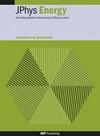Charge transport modelling of perovskite solar cells accounting for non-Boltzmann statistics in organic and highly-doped transport layers
IF 6.3
3区 材料科学
Q1 ENERGY & FUELS
引用次数: 0
Abstract
We present a drift–diffusion model of a perovskite solar cell (PSC) in which carrier transport in the charge transport layers (TLs) is not based on the Boltzmann approximation to the Fermi–Dirac (FD) statistical distribution, in contrast to previously studied models. At sufficiently high carrier densities the Boltzmann approximation breaks down and the precise form of the density of states function (often assumed to be parabolic) has a significant influence on carrier transport. In particular, parabolic, Kane and Gaussian models of the density of states are discussed in depth and it is shown that the discrepancies between the Boltzmann approximation and the full FD statistical model are particularly marked for the Gaussian model, which is typically used to describe organic semiconducting TLs. Comparison is made between full device models, using parameter values taken from the literature, in which carrier motion in the TLs is described using (I) the full FD statistical model and (II) the Boltzmann approximation. For a representative TiO2/MAPI/Spiro device the behaviour of the PSC predicted by the Boltzmann-based model shows significant differences compared to that predicted by the FD-based model. This holds both at steady-state, where the Boltzmann treatment overestimates the power conversion efficiency by a factor of 27%, compared to the FD treatment, and in dynamic simulations of current–voltage hysteresis and electrochemical impedance spectroscopy. This suggests that the standard approach, in which carrier transport in the TLs is modelled based on the Boltzmann approximation, is inadequate. Furthermore, we show that the full FD treatment gives a more accurate representation of the steady-state performance, compared to the standard Boltzmann treatment, as measured against experimental data reported in the literature for typical TiO2/MAPI/Spiro devices.考虑有机和高掺杂传输层中非Boltzmann统计的钙钛矿太阳能电池的电荷传输模型
我们提出了一个钙钛矿太阳能电池(PSC)的漂移-扩散模型,与之前研究的模型相比,电荷传输层(TL)中的载流子传输不是基于费米-狄拉克(FD)统计分布的玻尔兹曼近似。在足够高的载流子密度下,玻尔兹曼近似失效,态密度函数的精确形式(通常假设为抛物线)对载流子输运有显著影响。特别是,深入讨论了态密度的抛物型、凯恩型和高斯型模型,结果表明,玻尔兹曼近似和全FD统计模型之间的差异对于高斯模型尤其明显,高斯模型通常用于描述有机半导体TL。使用从文献中获得的参数值在全器件模型之间进行比较,其中使用(I)全FD统计模型和(II)玻尔兹曼近似来描述TL中的载流子运动。对于代表性的TiO2/MAPI/Spiro器件,由基于Boltzmann的模型预测的PSC的行为与由基于FD的模型预测相比显示出显著差异。这在稳态下和电流-电压滞后和电化学阻抗谱的动态模拟中都适用,在稳态下,玻尔兹曼处理将功率转换效率高估了27%。这表明,基于玻尔兹曼近似对TL中的载流子输运进行建模的标准方法是不够的。此外,我们表明,与标准Boltzmann处理相比,完全FD处理可以更准确地表示稳态性能,这是根据文献中报道的典型TiO2/MAPI/Spiro器件的实验数据进行测量的。
本文章由计算机程序翻译,如有差异,请以英文原文为准。
求助全文
约1分钟内获得全文
求助全文
来源期刊

Journal of Physics-Energy
Multiple-
CiteScore
10.90
自引率
1.40%
发文量
58
期刊介绍:
The Journal of Physics-Energy is an interdisciplinary and fully open-access publication dedicated to setting the agenda for the identification and dissemination of the most exciting and significant advancements in all realms of energy-related research. Committed to the principles of open science, JPhys Energy is designed to maximize the exchange of knowledge between both established and emerging communities, thereby fostering a collaborative and inclusive environment for the advancement of energy research.
 求助内容:
求助内容: 应助结果提醒方式:
应助结果提醒方式:


